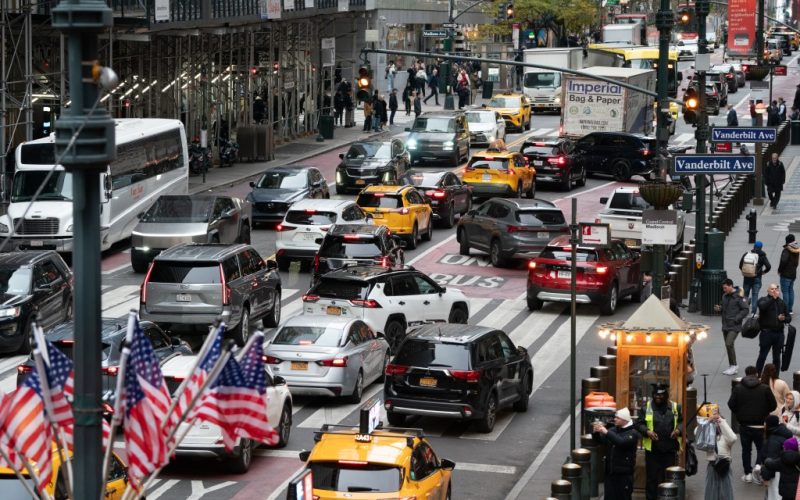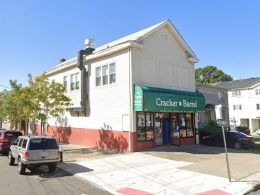New York City’s congestion pricing plan is back and set to kick in on Jan. 5, Gov. Hochul announced Thursday.
But the daily toll — which Hochul put on indefinite hiatus this past June, three months before it was supposed to go into effect — will be $9 rather than the original planned toll of $15 for at least three years, at which point it will be reassessed.
“We’re still getting the $15 billion to fund the MTA,” Hochul told reporters, “and drivers will be paying $6 less.”
The initial toll, reached after years of deliberation among state lawmakers, transit officials and federal regulators, had planned to charge motorists a base toll of $15 a day for entering Midtown and lower Manhattan by car. Larger vehicles would have been tolled at a greater rate, and late-night drivers or those who had already paid a toll at one of the tunnels would receive discounts.
The revenue from the congestion toll — a projected $900 million annually — would then have gone to pay off the debt on $15 billion in new MTA bonds meant to fund a long list of projects on the agency’s 2020-2024 capital plan.
As previously reported by the Daily News, Hochul’s modified plan, formally announced Thursday, keeps the same mechanisms but slashes each of those figures by 40%.
That brings the $15 base toll for passenger cars down to $9 per day, and the $3.75 late-night rate down to $2.25. The plan also reduces the tolling credits — discounts given to drivers who already paid a toll to enter the city by tunnel — by 40%.
That will mean less revenue to go toward MTA debt service, even as it’s assumed there will be more cars driving into the city than under a $15 toll. Kathryn Garcia, the state’s director of operations, estimated tolling revenues will come in closer to $600 million a year.
State officials said Thursday that, despite lower revenues, the tolling would raise $15 billion in borrowed money over a longer period of time — likely with the MTA selling tranches of bonds more slowly.
“Under any bonding scheme, it’s a multi-year proposal,” said Blake Washington, the state’s budget director. “The approach that we have today fully funds the capital plan over several years.”
That means that while all of the projects reliant on congestion pricing — a list that includes phase 2 of the Second Ave. subway, elevators at 23 subway stations, and modern computerized signaling on a slew of subway lines — are expected to be funded, some of that money could take longer to secure and some projects may have to wait in line.

Sources in both Hochul’s office and the MTA suggested to The News that big-ticket items like the Second Ave. subway and the legally mandated accessibility upgrades would be at the top of the list. The $15 billion had also been slated to pay for $3 billion in modern subway signals, $3 billion in repair work, and $1.5 billion in new subway cars, among other priorities.
Despite that, MTA leadership — which stopped awarding new capital contracts amid the congestion pricing confusion this summer — said Thursday’s announcement would allow work to begin again quickly.
“Now we know we have a source [of funding], so we can actually start to move projects forward,” MTA chairman Janno Lieber said.
“We will be putting out the [request for proposals] for the tunnel boring on the Second Ave. subway promptly, as a result of the actions taken by the governor today.”
The modified toll still has several procedural hurdles to clear before the MTA can begin charging motorists.
The transit agency’s board, which voted to green-light the original $15 toll in March, must sign off on the $9 initial toll before it can get sent to federal regulators for their approval. The MTA board is expected to do that on Monday.

Barry Williams for New York Daily News
Congestion pricing toll readers on Park Ave. at E. 61st St. in Manhattan. (Barry Williams for New York Daily News)
State law then requires three more weeks of public notification, during which the city, state and federal departments of transportation are expected to sign off on the plan a final time.
Meanwhile, congestion pricing still faces legal challenges from the state of New Jersey and others — challenges that were paused along with the tolling plan this summer, and may now come roaring back.
“Am I confident there won’t be lawsuits? No, I’m in the middle of nine right now,” Hochul said when asked about that possibility. “We’ve been sued every day of the week it seems — this whole issue has been a growth industry for lawyers.”
“I’m not afraid of any threats of litigation,” she said. “We’re not worried about it.”








